|
Celebrating the publication of Ezio's Phys. Rev. Lett., 112, 047201 (2014). Happy times and very tasty burgers at Butcher's Market! From left to right: Afshin, Randy, Johan, Yuli, Ezio, Masoumeh and Philipp.
0 Comments
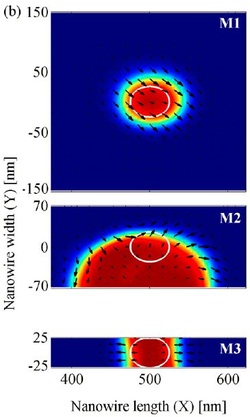 This analytical and numerical work builds on our previous experimental demonstration of magnetic droplet solitons [Science 339, 1295 (2013)] where we confirmed the predictions by Ivanov and Kosevich from over 35 years ago [Zh. Eksp. Teor. Fiz. 72, 2000 (1977)] and the more recent predictions by Hoefer, Silva and Keller [Phys. Rev. B 82, 054432 (2010)]. Droplets form naturally in systems with attractive forces. Water droplets are e.g. formed from the attractive polar interactions between water molecules. In ultrathin magnetic films the so-called perpendicular magnetic anisotropy (PMA) can create an attraction between spin wave excitations (magnons) and if a sufficient number of magnons are present in a region (analogous to a sufficient number of water molecules) they can condense into a magnetic droplet soliton. Much like water on extended surfaces, droplets are easily formed in extended PMA layers. However, the nucleation in a narrow channel is not easily predicted. In this paper, we show by numerical simulations that magnetic droplets can indeed be excited in nanowires and in doing so can acquire two novel forms: an edge and a quasi-one-dimensional (Q1D) nanowire mode. The edge mode arises as the physical boundaries attract the droplet the same way as a water drop would be attracted by a neighboring polar surface, e.g. a piece of glass. On the other hand, the Q1D exists in very narrow wires, where both boundaries attract the droplet. As a result, the Q1D acquires an additional property known as chirality which is a well-defined magnetic state that makes it especially resistant to disturbances. Due to these characteristics, such novel droplet modes can be identified by their intrinsically different frequency. Our simulations suggest means to experimentally prepare and observe these modes for their detailed physical study and in the prospect of nanoscopic applications for data storage. E. Iacocca, R.K. Dumas, L. Bookman, S.M. Mohseni, S. Chung, M. Hoefer, and J. Åkerman, Con fined dissipative droplet solitons in spin-valve nanowires with perpendicular magnetic anisotropy, Phys. Rev. Lett. 112, 047201 (2014). 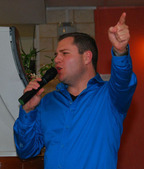 Today we congratulate Randy who has been invited to present an invited talk at the American Physical Society March Meeting in Denver, March 2014. His presentation will be based on his recent work on spin wave self-localization and spin wave mode co-existence in nano-contact spin torque oscillators [1]. [1] Spin wave mode coexistence: A consequence of the Oersted field induced asymmetric energy landscape, R. K. Dumas, E. Iacocca, S. Bonetti, S. R. Sani, M. S. Mohseni, A. Eklund, J. Persson, O. Heinonen, and Johan Åkerman, Phys. Rev. Lett., 110, 257202 (2013) 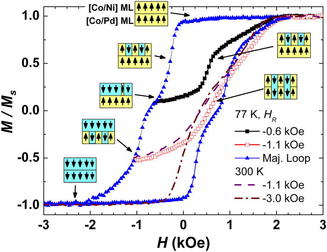 We have observed distinct temperature-dependent magnetization reversal modes in a perpendicular (Co/Pd)4/Co/Cu/(Co/Ni)4/Co pseudo-spin-valve, which are correlated with spin-transport properties. At 300 K, magnetization reversal occurs by vertically correlated domains. Below 200 K the hysteresis loop becomes bifurcated due to laterally correlated reversal of the individual stacks. The magnetic configuration change also leads to higher spin disorders and a significant increase in the giant magnetoresistance effect. First order reversal curve measurements reveal that the coupled state can be re-established through field cycling and allow direct determination of the interlayer coupling strength as a function of temperature. J. E. Davies, D. A. Gilbert, S. M. Mohseni, R. K. Dumas, J. Åkerman, and Kai Liu, APL 103, 022409 (2013). 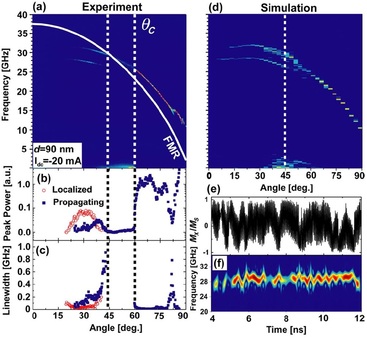 It has been argued that if multiple spin wave modes are competing for the same centrally located energy source, as in a nanocontact spin torque oscillator, that only one mode should survive in the steady state. Here, the experimental conditions necessary for mode coexistence are explored. Mode coexistence is facilitated by the local field asymmetries induced by the spatially inhomogeneous Oersted field, which leads to a physical separation of the modes, and is further promoted by spin wave localization at reduced applied field angles. Finally, both simulation and experiment reveal a low frequency signal consistent with the intermodulation of two coexistent modes. Randy K. Dumas, E. Iacocca, S. Bonetti, S. R. Sani, S. M. Mohseni, A. Eklund, J. Persson, O. Heinonen, and Johan Åkerman, Spin-Wave-Mode Coexistence on the Nanoscale: A Consequence of the Oersted-Field-Induced Asymmetric Energy Landscape, PRL 110, 257202 (2013). 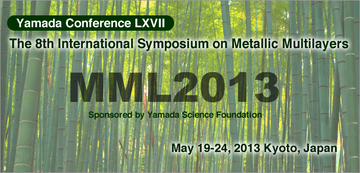 MML (International Symposium on Metallic Multilayers) is one of the best thin film magnetism conferences out there. The 8th version of it was no exception. Randy Dumas and Johan Åkerman attended and presented two posters [1,2] and an invited talk [3]. The next MML 2016 will be held in Uppsala, Sweden! Expect to see the entire Åkerman Group to be attending, if allowed. [1] "A non-volatile spintronic memory element with a continuum of resistance states", Y. Fang, R. Dumas, T. Anh Nguyen, S. Mohseni, S. Chung, C. Miller, J. Åkerman, Poster P-71 [2] "Spin wave mode coexistence in nanocontact spin torque oscillators", R. Dumas, E. Iacocca, S. Bonetti, S. Sani, M. Mohseni, A. Eklund, J. Persson, O. Heinonen, J. Åkerman, Poster P-124 [3] "Magnetic droplet solitons in nano-contact spin-torque oscillators with perpendicular magnetic anisotropy", J. Åkerman, M. Mohseni, S. Sani, J. Persson, A. Nguyen, S. Chung, Y. Pogoryelov, P. Muduli, E. Iacocca, A. Eklund, R. Dumas, S. Bonetti, A. Deac, M. Hoefer, Invited Talk We-1 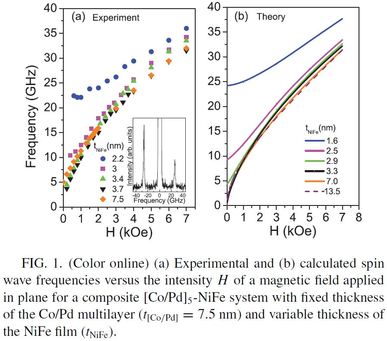 Anh Nguyen, Randy Dumas and Johan Åkerman have published a paper in Phys. Rev. B on Brillouin Light Scattering measurements of fundamental spin wave modes in tilted exchange springs [1]. These results are part of an ongoing collaboration with the University of Perugia, Italy, and also involved collaborators from Florence, Italy, and NIST Gaithersburg, USA. [1] S. Tacchi, T. N. Anh Nguyen, G. Carlotti, G. Gubbiotti, M. Madami, R. K. Dumas, J. W. Lau, Johan Åkerman, A. Rettori, and M. G. Pini, "Spin wave excitations in exchange-coupled [Co/Pd]-NiFe films with tunable tilting of the magnetization", Phys. Rev. B 87, 144426 (2013) 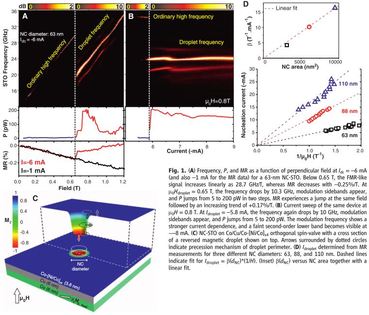 Drops are natural objects in systems with attractive forces. Water drops are e.g. formed from the attractive polar interaction between the H atoms in one H2O molecule and the O atom in another. In ultrathin magnetic films the so-called perpendicular magnetic anisotropy (PMA) can create an attraction between spin wave excitations (magnons) and if a sufficient number of magnons are present in a region (analogous to a sufficient number of water molecules) they can condense into a magnon drop where all spins in the drop precess in-phase on a single magnon frequency. Magnon drops were predicted theoretically by Ivanov and Kosevich over 35 years ago [Zh. Eksp. Teor. Fiz. 72, 2000 (1977)]. More recently, Hoefer, Silva and Keller demonstrated analytically and numerically that nano-contact spin torque oscillators (NC-STOs) with PMA free layers should be able to nucleate and sustain the dissipative (= lossy and actively driven) analogue of magnon drops; they called this new potential soliton object a magnetic droplet [Phys. Rev. B 82, 054432 (2010)]. In this work, we present the first experimental demonstration of magnetic droplets. Our devices consist of NC-STOs with a Co fixed layer and a [Co/Ni] multilayer free layer. The creation of a magnetic droplet is experimentally observed as a dramatic 10 GHz drop in the measured microwave frequency, accompanied with a sharp increase in the device resistance. The droplet displays a wide range of additional magnetodynamic phenomena, experimentally observed as a number of sidebands at different frequencies. Our work both brings closure to a long-standing theoretical prediction and provides the nanomagnetic and spintronic community with a novel dynamic nanomagnetic object, which joins the magnetic domain wall and magnetic vortex with similar potential for rich science. S. M. Mohseni, S. R. Sani, J. Persson, T. N. Anh Nguyen, S. Chung, Ye. Pogoryelov, P. K. Muduli, E. Iacocca, A. Eklund, R. K. Dumas, S. Bonetti, A. Deac, M. A. Hoefer, and J. Åkerman, Spin Torque–Generated Magnetic Droplet Solitons, Science 339, 1295 (2013). |
Archives
January 2016
Categories
All
|

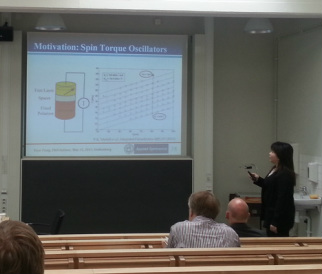
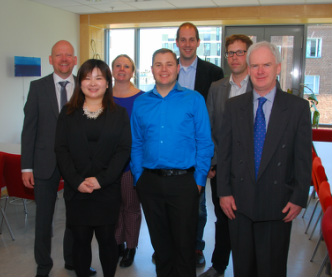
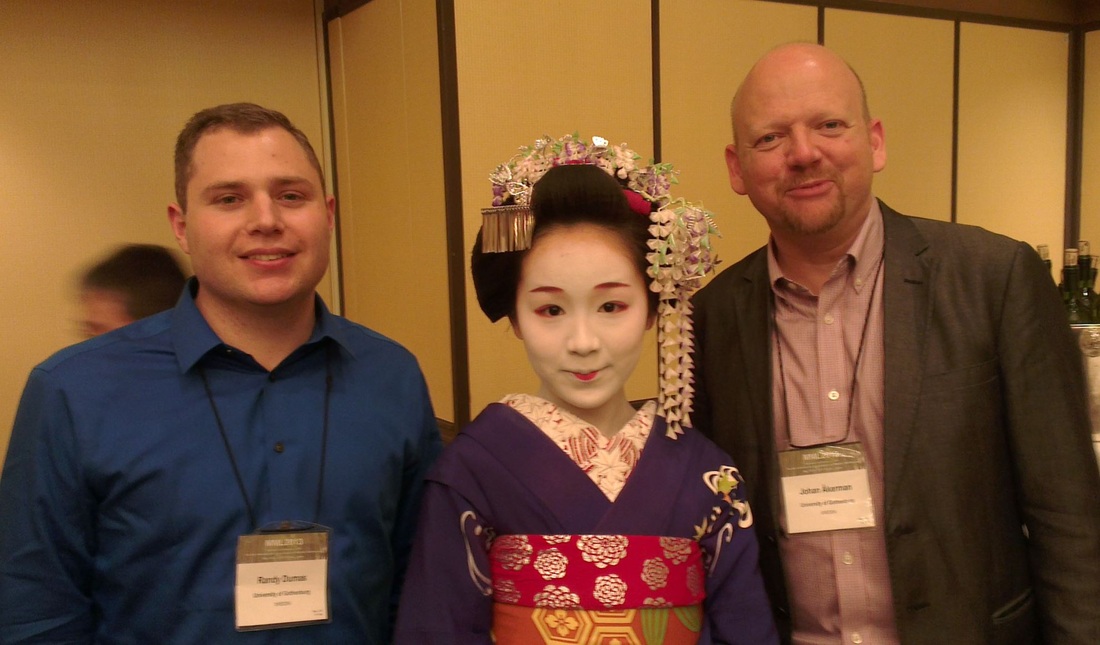

 RSS Feed
RSS Feed